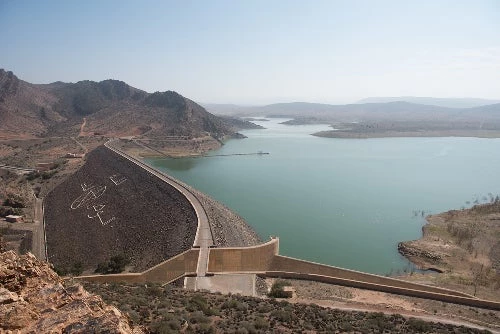From August 27 to 31, 2017, Stockholm, Sweden's capital city, will host World Water Week, the World Bank-organized annual conference on water and water management. A special session on Tuesday, August 29 will focus on water resources management in the Middle East and North Africa (MENA) region, where water shortage is becoming more and more acute. This session will also focus on the launch of the World Bank's new report entitled Beyond Scarcity: Water Security in the Middle East and North Africa. Ms. Charafat Afilal, Morocco's State Secretary in charge of Water, who will participate in this session, shares with us her reflections on the water management challenges facing her country.
The following achievements contributed to this undeniable success:
The policy of controlling and mobilizing water resources through the construction of large dams that play a flow regulation role by storing rainwater for use during dry periods and for irrigation purposes.
- A long-term planning policy launched in the early 1980s that allows decision makers to anticipate shortages by providing public authorities with a picture of water resource availability over a 20-to 30-year period.
- Major strides at the regulatory and institutional level to enhance water management efficiency across the territory. This pertains to the adoption of crucial pieces of legislation such as Law 10-95 for integrated, participatory, and decentralized water resources management through the establishment of water basin agencies and the implementation of mechanisms for the protection of water resources.
- The development of technical and scientific research skills in the relevant agencies at both the central and local levels.
As a result of these policies and investments, Morocco now has 140 large dams with a capacity exceeding 17.6 billion m3 and several thousand boreholes and wells to capture groundwater. This has helped secure the drinking water supply for Moroccan communities and develop a large-scale modern irrigation system (covering close to 1.5 million hectares), with a view to meeting the growth ambitions of an increasingly competitive agricultural sector. These policies also include integrated risk management systems through better protection of communities and properties from flooding, as well as water use for hydropower generation.
The water sector nevertheless continues to grapple with major challenges related to the depletion of water resources, the intensification of extreme climate events (floods and droughts) caused by climate change, and inadequate resources to meet growing needs coupled with overexploitation of groundwater resources.
To address these challenges and ensure the country's water security, the National Water Plan (PNE), a benchmark strategy for water policy in Morocco, was finalized in 2015 and is based on three areas:
1. Water demand management and water use efficiency:
With respect to the drinking water supply, in addition to the objectives of providing universal access to safe drinking water, the Government has worked on improving the output of drinking water supply networks by adopting a drinking water conservation program that essentially entails the rehabilitation of supply networks, improved metering, maintenance and upkeep of the networks, sectorization and restructuring, research, and the repair of leaks.
In the area of agriculture, the Green Morocco Plan has provided the appropriate institutional framework and the impetus needed to mobilize the financial and technical resources to modernize the irrigation system in the agricultural sector. Under the PNE, execution of the localized irrigation conversion program provided for in the Green Morocco Plan 2020 will continue until 2030, with a goal of reaching 70 percent of the overall irrigated area. A total of 450,000 hectares, at an average of 50 000 ha/yr, has already been converted to localized irrigation.
To enhance water use efficiency, the Government has stepped up the hydro-agricultural development program downstream of dams already in place or under construction. This program will facilitate the improved use of the regulated volumes not yet used in irrigation, largely through the Al Wahda Dam.
3. Conservation of water resources and the natural environment and climate change adaptation through conservation of the quality of the water resources, sustainable groundwater management, watershed development and the protection of sensitive areas (wetlands and oases).
The PNE also includes a flood protection and drought relief component aimed at responding to the challenge of adapting to climate change and more effectively managing extreme natural phenomena.
With regard to regulations for the implementation of the PNE, the body of legislation and regulations continues to be strengthened, notably with the adoption in August 2016 of a new Water Law (No. 36-15) that pursues the objectives of Law 10-95 and stipulates the rules for integrated, decentralized, and participatory water resources management, with a view to guaranteeing the right of citizens to have access to water. Thus, this new law introduced reforms aimed primarily at consolidating and strengthening decentralized, integrated, and participatory management and planning of water resources, strengthening consultation and coordination bodies and organizations through the establishment of the water basin council, establishing legal foundations to diversify supply sources through the use of unconventional water resources including desalinated seawater, implementing water-related information systems, strengthening the institutional framework and mechanisms for the protection and conservation of water resources, and strengthening financial instruments for the development of the water sector along the principle: user pays/polluter pays.
As a result of this significant progress and the ongoing updating of the water policy, Morocco has been able to plan the actions to be taken to ensure the country's water security, even in times of drought. These efforts must be continued in order to support socioeconomic development—especially in the face of new climate change-related challenges—through the commitment of all actors, the sharing of experiences, and the strengthening of international cooperation on water.


Join the Conversation